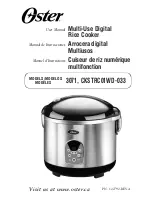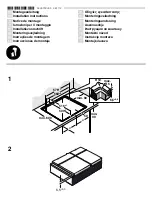
1 2
GB
Main Oven
Oven Control
Heating of the oven is achieved by turning control
clockwise to the required temperature scale on the
control panel, as recommended in the temperature
charts. The indicator light will immediately come on
and will then automatically go off and on during
cooking as the oven thermostat maintains the correct
temperature.
The cooking charts provided in this book are a guide
only, giving approximate cooking temperatures and
times. To suit personal taste and requirements, it may
be necessary to increase or decrease temperatures
by 10°C.
The oven is fitted with two rod shelves. The oven is
heated by two tubular sheathed elements located
under the floor of the oven and on the oven roof, inside
the cavity. It should be noted that at the end of a
cooking period there may be a momentary puff of
steam when the oven door is opened. This will
disperse in a few seconds and is a perfectly normal
characteristic of an oven with a good door seal.
Oven Positions
The correct positioning of food is indicated in the
temperature charts.
To prepare meat and poultry for roasting in your
conventional oven.
(a)Wipe the joint, dry well with a clean cloth, kitchen
tissue etc. and weigh it. Meat which has been
stored in a refrigerator should be allowed to come
to room temperature for approximately 30 minutes
before cook ing, and frozen meat or poultry must
be completely defrosted before placing in the
oven.
(b)The weight of any stuffing used should be added
to the oven ready weight of the meat / poultry
before calculating the cooking time.
(c)Place the joint in the meat pan supplied with your
cooker. Small joints weighing less than 1.75kg
(31/2 lbs) should be roasted in a smaller meat
pan/tin - or they may be ‘pot roasted’ - a small
joint in a large meat pan causes unnecessary
oven splashing and evaporation of meat juices.
(d)Additional fat should not be added, except for
veal, very lean meat or poultry which can either be
‘larded’ with fat bacon or brushed very
very
very
very
very
sparingly
sparingly
sparingly
sparingly
sparingly with cooking oil or melted fat.
(e)Beef, lamb, mutton and poultry may be dusted
lightly with seasoned flour to give a crisp outer
surface. The skin of duck and goose should be
pricked to release excess fat during cooking, and
the rind of pork should be scored, brushed lightly
with oil, and rubbed with salt, to give crisp
crackling.
(f) Potatoes for roasting only require to be brushed
with cooking oil or melted fat.
(g)It is not necessary to baste when roasting in an
electric oven and stock or liquid should not be
added to the meat pan since this only causes
unnecessary soiling, steam and condensation.
For optimum cooking performance, there must be
clearance between meat pan and oven sides. The
meat pan must be placed lengthways in the oven to
allow for air circulation.
Times and Temperatures for Roasting
The secret of succulent, tender meat, is not to roast it
too quickly, at too high a temperature. Best results
are obtained when roasting is carried out at a low
temperature. When a lower temperature is used, the
joint loses less weight, is more tender (too high a
temperature causes meat to be tough and dry) and
the splashing of fat onto the oven interior is reduced to
a minimum. When a complete meal is being cooked
in the oven, cooking time may need to be increased
and temperature may need to be raised for
approximately the last 30 minutes of the cooking
period (for instance when cooking Yorkshire pudding
to serve with roast beef). The suggested times and
temperatures should be used as a guide, but may
vary according to:-
1. Whether you prefer meat rare, medium or well
done.
2. The size and shape of your joint.
(a)A short thick joint requires a longer cooking
period than a long thin joint.
(b)A small joint under 1.5kg (3 lbs) takes longer per
450g (1 lb) cook in the time given for ‘minutes’ per
450g (1 lb) without the ‘minutes’ over added.
(c)Boned/rolled and stuffed joints take longer to
cook through than those with a bone.
N . B .
N . B .
N . B .
N . B .
N . B .
R
emember to switch off the oven control after cooking
is finished. If the door of the oven is left open for long
periods of time with the control switch ON, then the
grill element will become hot. The correct positioning
of food is indicated in the temperature charts.
Содержание IT50C S
Страница 22: ...2 2 GB ...
Страница 23: ...2 3 GB ...
Страница 24: ...2 4 GB 07 2011 195090125 01 XEROX FABRIANO ...










































